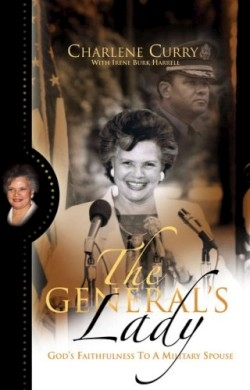The General's Lady
God's Faithfulness to a Military Spouse
Mid-twentieth-century young women dreamed of love and marriage and expected an easy transition from obedient daughter to adoring wife. Their individual stories often revealed the difficulties they encountered adjusting their ideal to reality. So it was with this author.
At age eighteen, she married Jerry Curry, a young man she’d loved since they first met eight years before. His career as an enlisted man in the Army took her away from the only home and family life she’d known. Frightened of thunderstorms, often sick and emotionally volatile during her husband’s long absences from home, she was forced to learn to take care of their four children and herself without him. Curry tells how Christian faith helped the family to cope with loneliness, war duty, and domestic and foreign moves.
The daughter of a coal miner, who grew up in McKeesport, Pennsylvania, Curry was raised strictly in an extended family of varied ethnic background. She writes, “My own people and Jerry’s were of mixed racial and national heritages—red, white, and blue/black, colors as American as the flag itself.”
Her husband’s first duty station in Georgia presented the challenge of living in the segregated South. “This overt racial separation and the fact that I was very shy by nature,” says the author, “made me slow in getting acquainted with other military wives.”
Despite some experiences with discrimination, Jerry made steady advancement from enlisted man to officer. He ultimately attained the position of Major General, a rare achievement for people of African American descent at that time. Meanwhile, Charlene matured from timid schoolgirl to self-assured hostess and supportive wife in a mutually enriching marriage.
They both advanced their spiritual understanding and learned to accept God’s spiritual presence in themselves. At one significant turning point, they saw the wisdom of employing a gentler method of discipline with their rebellious teenage son. Curry describes her husband’s behavior as he confronted the boy: “I could see him in my mind’s eye taking off his belt as he had done many times in the past. I prayed the physical punishment would accomplish its purpose.” Instead her husband explained to the boy that his behavior problem was not physical but spiritual and prayed with him.
The first-person narrative sometimes lags into personal detail and commentary. But internal dialog expressing the author’s emotional reactions works well, as do examples of the loving bond that she and her husband share with their birth families.
This story of two children who fall in love, grow up and build a productive life together based on Christian faith will inspire people interested in understanding the power of spiritual belief.
Reviewed by
Margaret Cullison
Disclosure: This article is not an endorsement, but a review. The publisher of this book provided free copies of the book to have their book reviewed by a professional reviewer. No fee was paid by the publisher for this review. Foreword Reviews only recommends books that we love. Foreword Magazine, Inc. is disclosing this in accordance with the Federal Trade Commission’s 16 CFR, Part 255.

